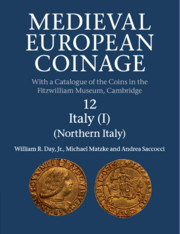Book contents
- Frontmatter
- Dedication
- Contents
- List of plates
- List of figures
- List of maps
- List of tables
- Preface
- Nomenclature
- List of abbreviations
- 1 GENERAL INTRODUCTION
- 2 ROYAL AND IMPERIAL COINAGES
- 3 PIEDMONT
- 4 LIGURIA
- 5 LOMBRDAY
- 6 veneto
- APPENDICES
- 1 Coin hoards and single-finds
- 2 Heraldry, saints, symbols
- 3 Metrology and compositional analyses
- 4 Glossary: coin names,weights and numismatic terms
- Bibliography
- SALE CATALOGUES
- CATALOGUE
- INDEXES
4 - Glossary: coin names,weights and numismatic terms
from APPENDICES
Published online by Cambridge University Press: 11 May 2017
- Frontmatter
- Dedication
- Contents
- List of plates
- List of figures
- List of maps
- List of tables
- Preface
- Nomenclature
- List of abbreviations
- 1 GENERAL INTRODUCTION
- 2 ROYAL AND IMPERIAL COINAGES
- 3 PIEDMONT
- 4 LIGURIA
- 5 LOMBRDAY
- 6 veneto
- APPENDICES
- 1 Coin hoards and single-finds
- 2 Heraldry, saints, symbols
- 3 Metrology and compositional analyses
- 4 Glossary: coin names,weights and numismatic terms
- Bibliography
- SALE CATALOGUES
- CATALOGUE
- INDEXES
Summary
Coins were occasionally given official names in mint ordinances, proclamations, etc., but are more often described as denari or grossi, terms that initially implied a specific identity or value but were also used in the general sense of ‘coin’, so that some further description was often necessary, e.g. grosso da dodici denari (‘groat of twelve pennies’).Official names were in any case supplemented by a variety of popular names, often of a mocking character.
The list that follows covers the medieval coin names of northern Italy, together with a few names of weights and of coins that did not originate in the area but were familiar there and occur in its records. Some coin names are based on terms of value, but the majority, at least initially, referred to specific coins. Confusion can arise from the way in which coin names that were initially specific, and based on the type (e.g. ambrosino) or value (e.g. sesino), could be generalised to cover coins of a particular size or denomination and then used for ones on which these particular features are absent or the values to which they referred no longer held good.
The most useful collection of Italian coin names and numismatic terms is in Martinori (1915), though its identifications and explanations are not always correct. For coin names alone, there is now also the glossary in Travaini (2003) for which the author draws directly on coin lists in medieval arithmetic tracts and merchants'manuals. The strong Mediterranean orientation inMateu y Llopis (1946) and the author's familiarity with both Spanish and Italian medieval documentary records likewise makes this a valuable reference. For similar reasons, the glossary in MEC 6 on the coinage of the Iberian peninsula is also helpful. The better German and French numismatic dictionaries are often useful for northern Italy, where cross-border influence was sometimes considerable (Schrotter 1930; Belaubre 1996; Amandry 2001). Etymologies proposed in standard dictionaries, however, are often unsatisfactory and should not be relied upon, since their authors have usually known little or nothing about the coins. Edler's otherwise very useful glossary of medieval Italian business terms (1934) pays little attention to coinage.
- Type
- Chapter
- Information
- Medieval European Coinage , pp. 729 - 749Publisher: Cambridge University PressPrint publication year: 2016

